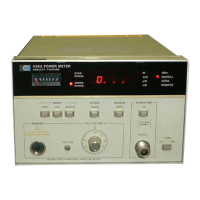•
•
Model 436A
Sending Data
Messages
(cont'd)
data
after taking a measurement. Thus, when the
interface bus is placed in
the
data mode after the
Power Meter has been addressed
to
talk,
the
time
required
to
access
the
first
output
data
character
depends
on
where
the
Power Meter
is
in the
operating program,
and
on
how
the
Power Meter
has been previously programmed (see Programming
Codes above.) Worst case access times for each
of
the Power Meter operating configurations are listed
in Table 3-5.
3-39. After
the
first
output
character
is
sent, the
remaining characters are sent
at
either a 10-kHz
rate (infinitely fast listener)
or
at
the
receive rate
of
the
slowest listener.
3-40. Receiving the Trigger
Message
3-41. The Power Meter has no provision for re-
sponding
to
a Trigger Message (bus command GET).
Power Meter triggering is
done
with the Data
Mes-
sage (through
the
Measurement Rate Program
Codes).
3-42. Receiving the Clear
Message
3-43. The Power Meter has provision for respond-
ing
to
the DCL bus
command
but
not
the
SDC
bus
command. Upon receipt
of
the
DCL command,
the
Power Meter operating program is reset causing the
Power Meter
to
enter
the
Hold state shown
at
the
top
of
Figure 3-6, and
the
HP-IB circuits are con-
figured
to
provide Watt Mode, Auto Range, and
Cal
Factor
Disable
outputs.
3-44. Receiving the Remote
Message
3-45. When the Power Meter recieves the Remote
Message (REN line low)
it
completes the rest
of
its
current measurement cycle (see Figure 3-6) and
then goes
to
remote. See
the
Local
to
Remote
Mode Change (paragraph 3-31)
for
information
about
how
to
program
the
local
to
remote mode
change.
3-46. Receiving the Local
Message
3-4 7. The Power Meter does
not
respond
to
the
GTL (go
to
local) bus command.
It
reverts
to
local
operation
when
the
REN (remote enable) bus
line goes false (high).
Operation
3-48. Receiving the Local Lockout
and
Clear
Lockout
Set
Local
Messages
3-49. The Power Meter does
not
respond
to
the
Local Lockout Message (LLO bus command).
It
responds
to
the Clear Lockout/Set Local Message
in
that
when the REN bus line goes false,
it
will
revert
to
local operation.
3-50. Receiving the
Pass
Control
Message
3-51. The Power Meter has no provision for oper-
ation
as a controller.
3-52. Sending the Required Service
Message
3-53. The Power Meter does
not
have provision
for
requesting service.
3-54. Sending the Status Byte
Message
3-55. The Power Meter does
not
respond
to
a
Serial Poll.
3-56. Sending the Status
Bit
Message
3-57. The Power Meter does
not
respond
to
a
Parallel Poll.
3-58. Receiving the
Abort
Message
3-59. When the Power Meter receives an Inter-
face Clear command (IFC), it stops talking
or
listening.
3-60. Test
of
HP-IB Operation
3-61. Figure 3-7 outlines a quick check
of
the
436A
remote functions. This gives the user
two
alternatives for testing
the
power meter: 1, write
a program corresponding
to
Figure
3-
7 for a quick
check
or
2, use the program in Section VIII for
complete
testing and troubleshooting.
3-62.
POWER
MEASUREMENT ACCURACY
3-63. A power measurement
is
never free from
error
or
uncertainty. Any RF system has RF losses,
mismatch
losses, mismatch uncertainty,
instrumentation uncertainty and calibration
uncertainty.
Measurement errors as high
as
50%
are
not
only
possible, they are highly likely unless
the
error
sources are understood and,
as
much as
possible, eliminated.
3-23

